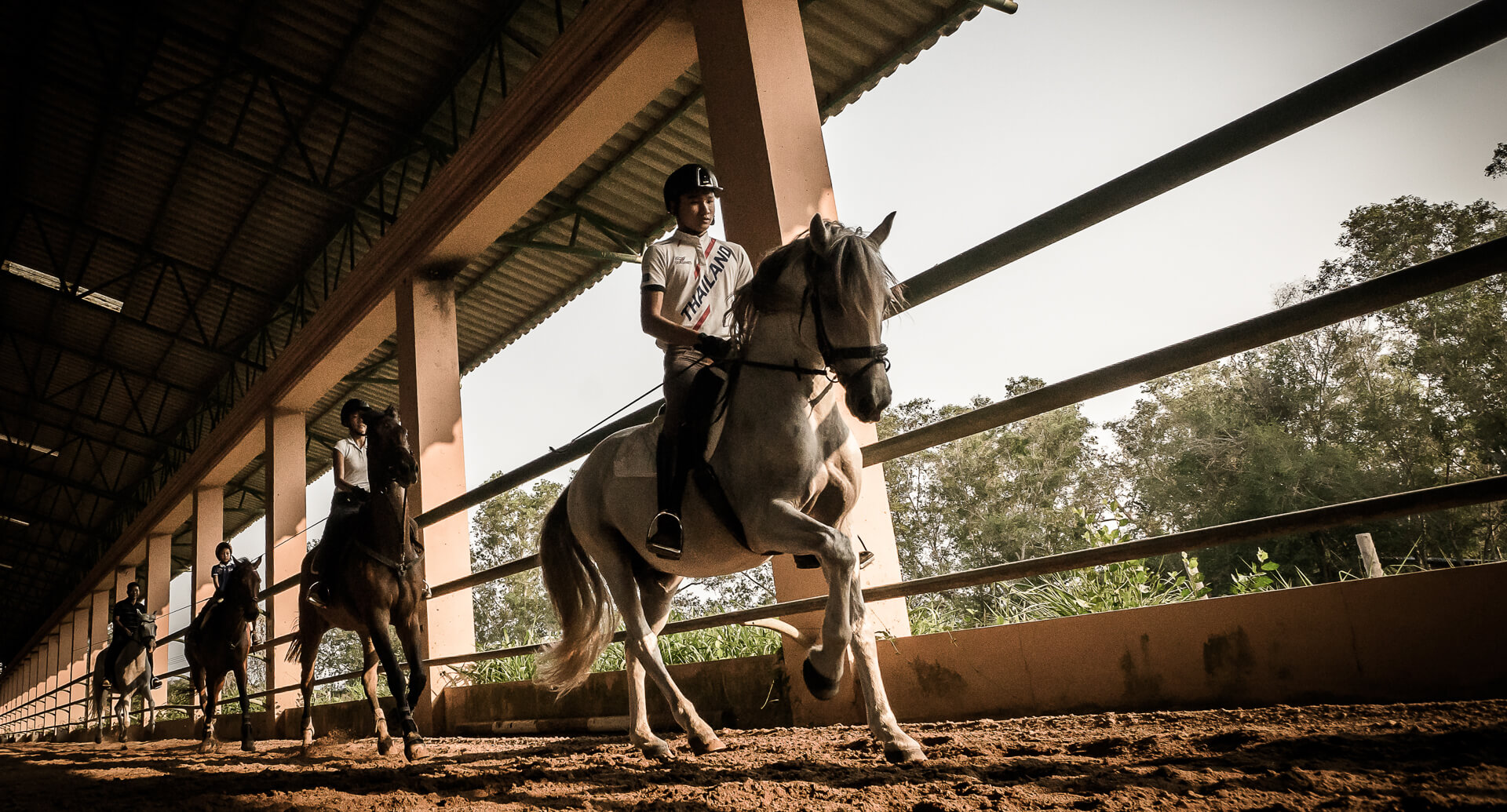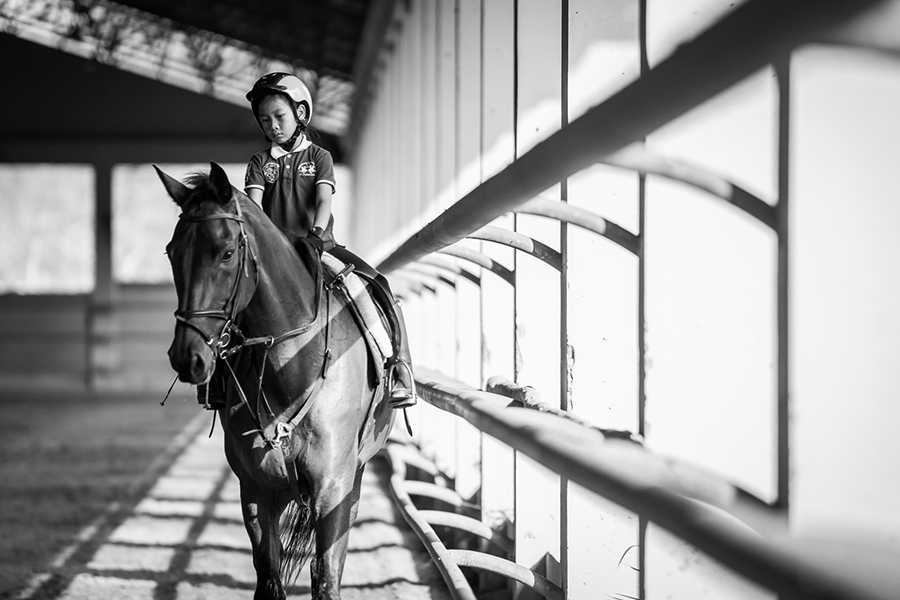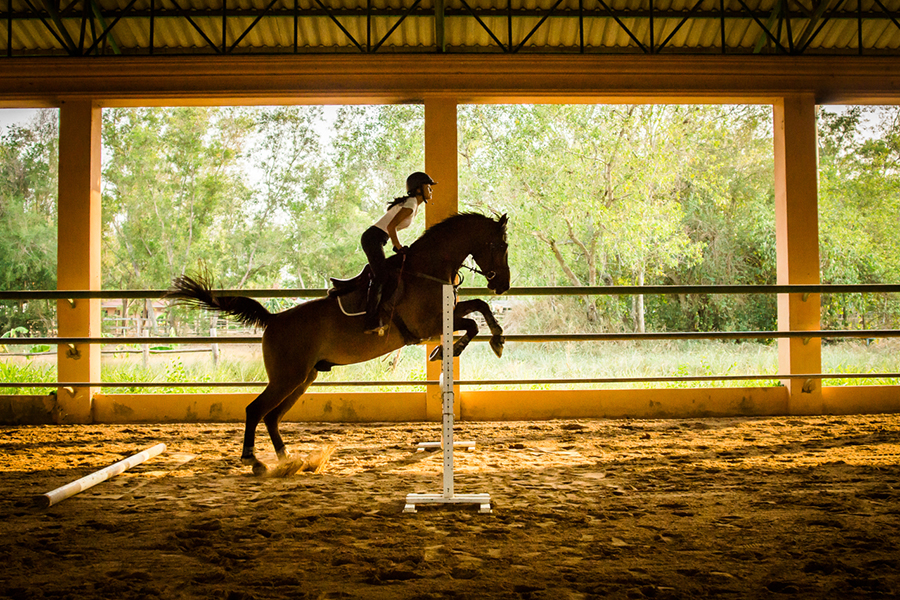- Lessons
- Activities
- Facilities
- Horses
Dressage
The object of dressage is the harmonious development of the physique and ability of the horse. As aresult it makes the horse calm, supple, loose and flexible, but also confident, attentive and keen; thus achieving perfect understanding with his rider.
Jumping
After all of the basics are learned, qualified instructors will teach you how to jump the horse over various obstacles. Jumping is a huge thrill that comes along with a great sense of achievment. Riders wishing to learn to jump will start riding over poles and cavalettis as soon as they are able to keep their balance in two point position and goback to rising trot without losing their balance or the rhythm of the trot. A course of riding trot and canter poles will be followed by learning to ride over cross rails and then to small verticals. Once the student has learned to ride the individual fences, the instructor will put them together and teach them how to ride the jumping course.
Jumping
The basic movements of classical riding are steps, trot and canter. In steps, the horse places his legs diagonally in front of eachother onto the ground so that all four hooves are heard. In trot, the diagonal pair of legs push off from the ground and touch the ground simultaneously again there is a second of floating and two hoof beats can be heard. In the canter, there is a row of jumps in which three hoof beats can be heard. More advanced movements include the piaffe, passage, side stepping and backward steps.
After initial assessment and recommendation by the instructor, more advanced riders may take classical riding lessons on purebred Lusitano stallions. The Lusitano is an ancient Portuguese breed of horse that until the 1960s shared its registration with the Spanish horse, the Anda- lusian. Both are sometimes called Iberian horses, as their land of origin is the Iberian peninsula. These Iberian horses were developed for use in war, dressage and bull fighting. Lusitanos make excellent riding horses due to their levelheaded temperament and tendency to bond strongly with humans. They are intelligent, sensible, and have great balance.
Pony Club
The Pony Club is an international youth organization for those interested in ponies and riding. It was founded in England in 1929 and is now represented in 15 countries and has a membership exceeding 100,000. It is the largest association of riders in the world and the majority of the most successful riders in all disciplines of British equestrian competition have been members of The Pony Club. The Pony Club is open to children and young adults aged 5 to 21. The aim of the club is to provide quality riding tuition as well as a full program to teach horse care and the basics of stable management.
Activities
Riding and safety (Beginners to Advanced)
Horse care
Gymkhanas
Training in dressage and show jumping
Competitions at home and elsewhere
Lectures from visiting horse experts
Camps held at the facility
All Participants will be eligible for the Pony Club Efficiency examinations and certificates.
Trail rides
Trail riding at the International Riding School at Horseshoe Point is a wonderful way to enjoy some time on horseback while discovering the natural surroundings over a wide variety of terrain.
We have numerous trails of various length and difficulty. Beginner riders will ride at a walk with a leading groom. More advanced riders will be in a separate group and can enjoy trot and canter.
Our scenic trail rides pass by sandy flats, man-made mini-lakes, hills, pineapple fields, rubber plantations, a golf course and small villages. Every trail features a different aspect of the surrounding valley and will make for a unique and memorable experience!
Able the Disabled
“Able The Disabled” is the Proactive Vision of two unique women, who grew up in separate parts of the World in different circumstances, but with a common passion. That passion evolved in to a reality as they became close friends; through combining riding and helping those less fortunate within Thailand they created “Able The Disabled.”.
For thousands of physically and mentally disabled people throughout the World riding horses and ponies has become their first step away from the protective shelter of home, or special school, to the hustle and bustle of the outside world. This has led to new occupations, careers, friendships and a more full and useful life in the community.
Many disabled people benefit from riding, some from the relaxation it gives, others by actually learning to ride. The benefits can be enormous and wide-ranging. They include improvement of balance, coordination, muscle tone, concentration, cooperation and behaviour. A feeling of independence and “I can do it!” is achieved. For many riders their visit to the stables is the thing that they look forward to most in their week and, in some cases, it maybe their only opportunity to meet others.
Disabled Riders also gain from the following:
• Improved health and well being.
• Heightened body awareness.
• Improved natural body reflexes.
• Improved balance and posture.
• Improved sequencing of actions.
• Increased hand – eye co-ordination.
• Development of gross and fine motor skills.
Stable
The Horseshoe Point has 200 individual stalls, each with a fan to pamper the horses. We also have many paddocks and lunging rings for exercising and training horses.
Riding Arenas
The Horseshoe Point boasts having 5 riding arenas (four of which are covered). Our Classical/Hotel arena is 60x25 meters, our Traditional/ Main House arena is 40x25 meters, our Olympic arena is 125x25 meters, Our outdoor arena is 75x55 meters and our Warm-Up arena is 40x20 meters. We also have a trimmed grass field for polo, jumping or leisure riding.
We have more than 80 horses of different breeds including Lusitano, Lipizzaner, Arab, Appaloosa, Australian Stock Horse, Royal Alter Real, Thoroughbred, DutchWarmblood, Trakehner, Falabella as well as the sturdy Thai Pony. Many of these animals have been imported from Europe, the USA and Australia over the last 25 years by the owning family. Here at the Horseshoe Point, our famous ones are;
LUSITANOS
The Lusitano is the Portuguese version of the Spanish Andalucian. It is a very cooperative, intelligent and responsive breed. Its action is also quick and balanced. As a result, it is growing in demand for use as a dressage horse.
Riding Arenas
The Falabella is the smallest breed of horse in the world. Descended from the Andalusian breed; developed in the pampas of Patagonia. It is known as a horse-type rather than a pony-type because of its proportions and character. Although downsizing has caused a few weak- nesses in the physical characteristics, the horse is quite attractive and developed great stamina.
Riding Arenas
The Lipizzaner horse is usually associated with the famous Spanish Riding School in Vienna. It is agile and athletic and its quiet temperament makes it especially suitable for the School disciplines. The colour is uniformly white, although foals are born black or brown.



